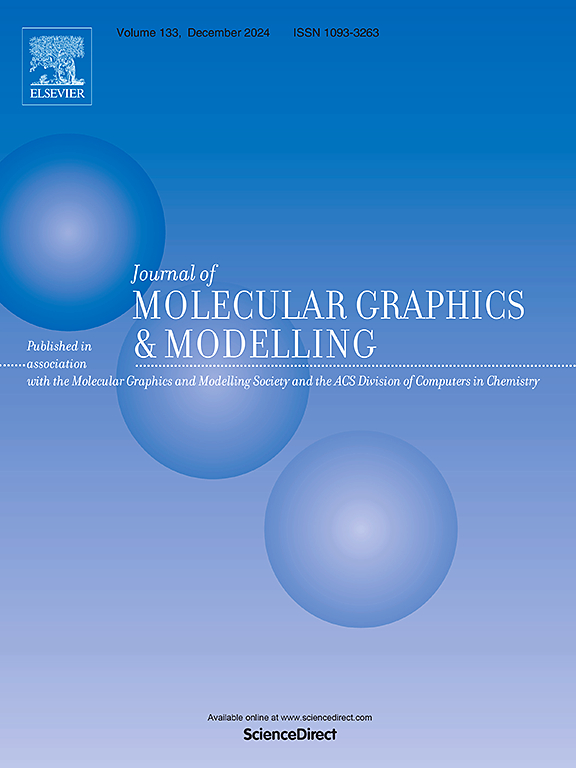Vibrational assignments, normal coordinates analysis, force constants, and DFT/MP2 computations of 5-Chloro-2,4,6-trifluoropyrimidine
IF 2.7
4区 生物学
Q2 BIOCHEMICAL RESEARCH METHODS
引用次数: 0
Abstract
The vibrational assignments of 5-Chloro-2,4,6-trifluoropyrimidine have been early investigated, however, the proposed fundamentals were not spanned to their appropriate species owing to neglecting the overall symmetry. Nevertheless, the lack of force constants (FCs) determination encourages us to reinvestigate the molecule. Aided by DFT (B3LYP, B3P86, B3PW91, ωBX97) and MP2 = full quantum chemical computations, we have provided a reliable vibrational analysis of all normal modes based on the C2v point group. Different methods of the currently used normal coordinate analysis were also validated. Our results are compared with available infrared and Raman spectral data, including estimated infrared intensities, Raman scattering activities, genuine FCs in internal coordinates, and potential energy distributions (PEDs). Using NCA in a well-defined internal coordinate that enables us to estimate FCs based on G.F. Wilson led to better fundamental interpretations than those obtained from atomic displacements in Cartesian coordinates, VEDA, and MOLVIB programs. The current investigation potentially offers corrected vibrational mode assignments, filling gaps in prior literature and aiding in accurately characterizing fluorinated pyrimidine derivatives.

5-氯-2,4,6-三氟嘧啶的振动赋值、法向坐标分析、力常数和DFT/MP2计算
对5-氯-2,4,6-三氟嘧啶的振动配位进行了较早的研究,但由于忽略了整体对称性,所提出的基本原理没有跨越到适当的物种。然而,缺乏力常数(FCs)的测定鼓励我们重新研究分子。借助DFT (B3LYP, B3P86, B3PW91, ωBX97)和MP2 =全量子化学计算,我们提供了基于C2v点群的所有正规模式的可靠振动分析。并对目前常用的法向坐标分析方法进行了验证。我们的结果与现有的红外和拉曼光谱数据进行了比较,包括估计的红外强度、拉曼散射活动、内部坐标中的真实fc和势能分布(ped)。在定义良好的内部坐标中使用NCA,使我们能够基于G.F. Wilson来估计fc,这比在笛卡尔坐标、VEDA和MOLVIB程序中从原子位移中获得的解释更好。目前的研究有可能提供修正的振动模式分配,填补先前文献的空白,并有助于准确表征氟化嘧啶衍生物。
本文章由计算机程序翻译,如有差异,请以英文原文为准。
求助全文
约1分钟内获得全文
求助全文
来源期刊

Journal of molecular graphics & modelling
生物-计算机:跨学科应用
CiteScore
5.50
自引率
6.90%
发文量
216
审稿时长
35 days
期刊介绍:
The Journal of Molecular Graphics and Modelling is devoted to the publication of papers on the uses of computers in theoretical investigations of molecular structure, function, interaction, and design. The scope of the journal includes all aspects of molecular modeling and computational chemistry, including, for instance, the study of molecular shape and properties, molecular simulations, protein and polymer engineering, drug design, materials design, structure-activity and structure-property relationships, database mining, and compound library design.
As a primary research journal, JMGM seeks to bring new knowledge to the attention of our readers. As such, submissions to the journal need to not only report results, but must draw conclusions and explore implications of the work presented. Authors are strongly encouraged to bear this in mind when preparing manuscripts. Routine applications of standard modelling approaches, providing only very limited new scientific insight, will not meet our criteria for publication. Reproducibility of reported calculations is an important issue. Wherever possible, we urge authors to enhance their papers with Supplementary Data, for example, in QSAR studies machine-readable versions of molecular datasets or in the development of new force-field parameters versions of the topology and force field parameter files. Routine applications of existing methods that do not lead to genuinely new insight will not be considered.
 求助内容:
求助内容: 应助结果提醒方式:
应助结果提醒方式:


